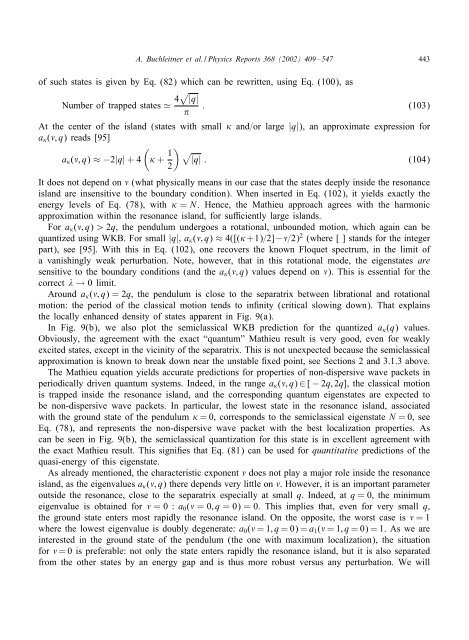Non-dispersive wave packets in periodically driven quantum systems
Non-dispersive wave packets in periodically driven quantum systems
Non-dispersive wave packets in periodically driven quantum systems
Create successful ePaper yourself
Turn your PDF publications into a flip-book with our unique Google optimized e-Paper software.
A. Buchleitner et al. / Physics Reports 368 (2002) 409–547 443<br />
of such states is given by Eq. (82) which can be rewritten, us<strong>in</strong>g Eq. (100), as<br />
Number of trapped states 4 |q| : (103)<br />
At the center of the island (states with small<br />
a ( ; q) reads [95]<br />
and=or large |q|), an approximate expression for<br />
<br />
a ( ; q) ≈−2|q| +4 + 1<br />
<br />
|q|<br />
:<br />
2<br />
(104)<br />
It does not depend on (what physically means <strong>in</strong> our case that the states deeply <strong>in</strong>side the resonance<br />
island are <strong>in</strong>sensitive to the boundary condition). When <strong>in</strong>serted <strong>in</strong> Eq. (102), it yields exactly the<br />
energy levels of Eq. (78), with = N . Hence, the Mathieu approach agrees with the harmonic<br />
approximation with<strong>in</strong> the resonance island, for su ciently large islands.<br />
For a ( ; q) ¿ 2q, the pendulum undergoes a rotational, unbounded motion, which aga<strong>in</strong> can be<br />
quantized us<strong>in</strong>g WKB. For small |q|, a ( ; q) ≈ 4([( +1)=2]− =2) 2 (where [ ] stands for the <strong>in</strong>teger<br />
part), see [95]. With this <strong>in</strong> Eq. (102), one recovers the known Floquet spectrum, <strong>in</strong> the limit of<br />
a vanish<strong>in</strong>gly weak perturbation. Note, however, that <strong>in</strong> this rotational mode, the eigenstates are<br />
sensitive to the boundary conditions (and the a ( ; q) values depend on ). This is essential for the<br />
correct → 0 limit.<br />
Around a ( ; q) =2q, the pendulum is close to the separatrix between librational and rotational<br />
motion: the period of the classical motion tends to <strong>in</strong> nity (critical slow<strong>in</strong>g down). That expla<strong>in</strong>s<br />
the locally enhanced density of states apparent <strong>in</strong> Fig. 9(a).<br />
In Fig. 9(b), we also plot the semiclassical WKB prediction for the quantized a (q) values.<br />
Obviously, the agreement with the exact “<strong>quantum</strong>” Mathieu result is very good, even for weakly<br />
excited states, except <strong>in</strong> the vic<strong>in</strong>ity of the separatrix. This is not unexpected because the semiclassical<br />
approximation is known to break down near the unstable xed po<strong>in</strong>t, see Sections 2 and 3.1.3 above.<br />
The Mathieu equation yields accurate predictions for properties of non-<strong>dispersive</strong> <strong>wave</strong> <strong>packets</strong> <strong>in</strong><br />
<strong>periodically</strong> <strong>driven</strong> <strong>quantum</strong> <strong>systems</strong>. Indeed, <strong>in</strong> the range a ( ; q) ∈ [ − 2q; 2q], the classical motion<br />
is trapped <strong>in</strong>side the resonance island, and the correspond<strong>in</strong>g <strong>quantum</strong> eigenstates are expected to<br />
be non-<strong>dispersive</strong> <strong>wave</strong> <strong>packets</strong>. In particular, the lowest state <strong>in</strong> the resonance island, associated<br />
with the ground state of the pendulum = 0, corresponds to the semiclassical eigenstate N = 0, see<br />
Eq. (78), and represents the non-<strong>dispersive</strong> <strong>wave</strong> packet with the best localization properties. As<br />
can be seen <strong>in</strong> Fig. 9(b), the semiclassical quantization for this state is <strong>in</strong> excellent agreement with<br />
the exact Mathieu result. This signi es that Eq. (81) can be used for quantitative predictions of the<br />
quasi-energy of this eigenstate.<br />
As already mentioned, the characteristic exponent does not play a major role <strong>in</strong>side the resonance<br />
island, as the eigenvalues a ( ; q) there depends very little on . However, it is an important parameter<br />
outside the resonance, close to the separatrix especially at small q. Indeed, at q = 0, the m<strong>in</strong>imum<br />
eigenvalue is obta<strong>in</strong>ed for =0 : a0( =0;q= 0) = 0. This implies that, even for very small q,<br />
the ground state enters most rapidly the resonance island. On the opposite, the worst case is =1<br />
where the lowest eigenvalue is doubly degenerate: a0( =1;q=0)=a1( =1;q=0)=1. As we are<br />
<strong>in</strong>terested <strong>in</strong> the ground state of the pendulum (the one with maximum localization), the situation<br />
for = 0 is preferable: not only the state enters rapidly the resonance island, but it is also separated<br />
from the other states by an energy gap and is thus more robust versus any perturbation. We will











